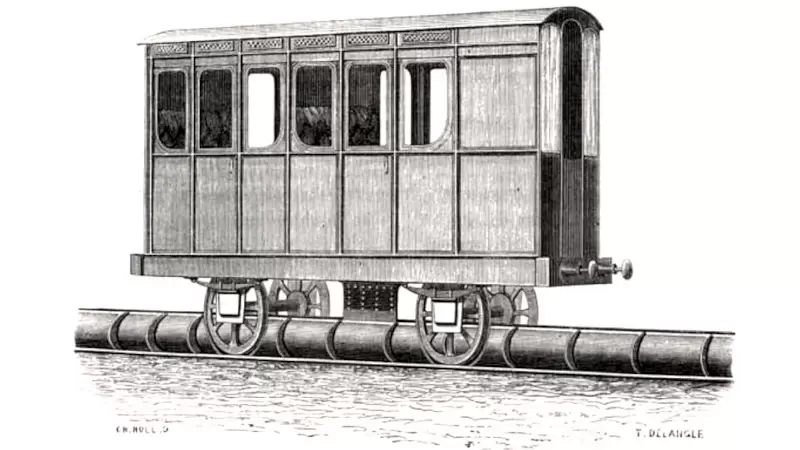It was pointed out to me recently that a paper (written by Tesla and SpaceX engineers) published by Elon Musk in 2013 credited the Hyperloop concept of a vacuum tube train to “The Limit of Rapid Transit” by Robert Goddard in 1909.
That’s a start. Goddard was a prodigious inventor who experimented a lot with vacuum and propulsion.
Some say the next big splashy Hyperloop advocate was in 1950s France.
The idea of the Aérotrain emerged in the mind of Jean Bertin during the 1950s.
He didn’t get very far.
And then MIT worked hard in the 1990s to bring Goddard’s ideas to reality.
Experiments conducted by Frankel and his team in the early 90s showed that it worked. “We built a half mile long tube at the playing fields of MIT, evacuated it, and then shot things through it in order to measure what sort of velocities we could obtain,” says Frankel. “We started with ping pong balls, and then went to mechanical models.” His team found that creating a near vacuum in the pipe would allow speeds of up to 930 km/h (580mph) – twice as fast as in an air filled tube.
The results were enough for the team to propose a rail system between Boston and New York…. Ultimately, the huge cost of building such a system was its downfall along with the fact that the top speed was equivalent to existing bullet trains…
Spoiler alert. Hyperloop concepts have failed miserably for at least 100 years because so complicated, expensive and in reality not much faster than existing trains.
In fact, when Elon Musk claimed to be proposing a competitive new transit idea, MIT slapped it down as a poorly-scoped hybrid of others’ ideas that would fail.
The idea of pushing pods along with air in a pneumatic tube has been around for at least 150 years. […] Unusual approaches to transportation like this one have, of course, had a difficult time getting implemented.
MIT really hinted at the fact that Musk was fraudulently proposing a highly expensive and experimental Hyperloop as the exact opposite: cheap and easy.
[Hansman] says Musk’s cost estimates are too optimistic. “It would be enormously expensive. And I think there are a huge number of technical challenges.” [Sussman says] “…given our inability to put together the package to do high-speed rail, which is proven technology, it’s hard to see how a chancy solution—given that it’s never been implemented—would fare,”
Ouch. Hyperloop has indeed fared terribly and delivered nothing, while trains are at least on track for 2030 (pun not intended).
Why did Musk lie and then deliver nothing? Politics. He wanted at that time to kill public transit funding in California, stop trains, by soaking attention up with a fictional future product that would never be delivered. It was the hydrogen highway tactic but targeted.
Wait, did MIT also say 150 years? Goddard was 1909, so something is off by like 40 years.
Digging around I noticed several people call out George Medhurst, who suggested compressed air to create car propulsion (including a 1799 design patent on a system of iron pipes for “atmospheric rails”).

That’s early!
And then in 1845 a London and Croydon Railway experiment ran a vacuum train, where atmospheric pressure propelled its cars. It ended with a familiar note.
…ultimately a failure due to the difficulty of maintaining a high pressure in the tubes with the ever complex valves requiring unaffordable levels of maintenance…
Wow, that sounds almost exactly like products from Elon Musk 2012-2024, no? Difficult and unaffordable maintenance is surely Tesla’s byline.
All I’m saying is that if you look at the long line of Hyperloop type inventors, someone could and should have predicted that a very old idea with well known problems would suffer the same fate.
[Burning through $300m in six years, by] 2020, Hyperloop One successfully conducted a crewed test run hitting 100 mph.
Pathetic. Hyperloop One squeezed out a pokey 100 mph before shutting down operations without a single buyer. What a waste of time and money. But do you know what’s even more pathetic?
The concept of the hyperloop – ultra high-speed transportation via pods or capsules travelling in near-vacuum tubes – originated in 2013 with a white paper by Elon Musk.
Almost nothing in that Musk glorification sentence is true. And the fact someone could write such nonsense might have something to do with why the Hyperloop was ever allowed to divert attention from actual high speed trains and fail so spectacularly… yet again.
